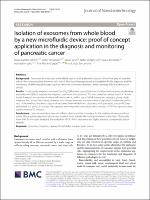Por favor, use este identificador para citar o enlazar este ítem:
https://repositorio.usj.es/handle/123456789/442
| Título : | Isolation of exosomes from whole blood by a new microfluidic device: proof of concept application in the diagnosis and monitoring of pancreatic cancer |
| Autor: | Sancho-Albero, M.


Sebastian, Victor 

Sesé, Javier 


Pazo-Cid, Roberto Antonio 


Mendoza, Gracia 

Arruebo, Manuel 


Martín-Duque, Pilar 


Santamaria, Jesus M. 

|
| Palabras clave : | Exomas; Captura magnética; Microfuidos y cáncer de páncreas |
| Fecha de publicación: | 22-oct-2020 |
| Editorial : | Springer Nature |
| Citación : | Sancho-Albero, M., Sebastián, V., Sesé, J., Pazo-Cid, R., Mendoza, G., Arruebo, M., Martín-Duque, P., Santamaría, J., 2020. Isolation of exosomes from whole blood by a new microfluidic device: proof of concept application in the diagnosis and monitoring of pancreatic cancer. Journal of Nanobiotechnology 18.. doi:10.1186/s12951-020-00701-7 |
| Resumen : | Background: Exosomes are endocytic-extracellular vesicles with a diameter around 100 nm that play an essential role on the communication between cells. In fact, they have been proposed as candidates for the diagnosis and the monitoring of different pathologies (such as Parkinson, Alzheimer, diabetes, cardiac damage, infection diseases or cancer). Results: In this study, magnetic nanoparticles (Fe3O4NPs) were successfully functionalized with an exosome-binding antibody (anti-CD9) to mediate the magnetic capture in a microdevice. This was carried out under flow in a 1.6 mm (outer diameter) microchannel whose wall was in contact with a set of NdFeB permanent magnets, giving a high magnetic field across the channel diameter that allowed exosome separation with a high yield. To show the usefulness of the method, the direct capture of exosomes from whole blood of patients with pancreatic cancer (PC) was performed, as a proof of concept. The captured exosomes were then subjected to analysis of CA19-9, a protein often used to monitor PC patients. Conclusions: Here, we describe a new microfluidic device and the procedure for the isolation of exosomes from whole blood, without any need of previous isolation steps, thereby facilitating translation to the clinic. The results show that, for the cases analyzed, the evaluation of CA19-9 in exosomes was highly sensitive, compared to serum samples. |
| URI : | https://repositorio.usj.es/handle/123456789/442 |
| ISSN : | 1477-3155 |
| Aparece en las colecciones: | Artículos de revistas |
Ficheros en este ítem:
| Fichero | Descripción | Tamaño | Formato | |
|---|---|---|---|---|
| Insolation of exosomes from whole blood by a new microfluidic devide.pdf | 3,72 MB | Adobe PDF |  Visualizar/Abrir |
Este ítem está sujeto a una licencia Creative Commons Licencia Creative Commons

